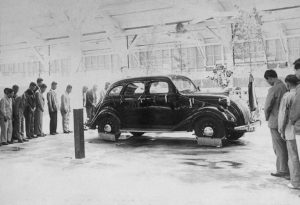As COVID-19 has presented new challenges to Rhode Island manufacturers, some of them have remarked to Polaris MEP that it would be great to have something “new,” some sort of “innovative” training that would magically help them make up for lost time.
My answer? Stop chasing the “new,” the latest shiny training fad.
There’s an effective training method that has been proven over 80 years to both reduce training time AND make workers more productive. It’s called Job Instruction.
A Global Challenge, An American Training Innovation
Sometime around 2007, a colleague and I went to see a panel discussion on Lean Manufacturing including the Director of Training for the new Toyota Manufacturing plant in Kentucky. Toyota was the pinnacle of Lean manufacturing, so this presentation was of great interest to me.
At the end of the panel members’ presentations, there was an open question and answer session. The questions from the audience that were directed at the Japanese Manager from Toyota were, in my opinion, a bit sarcastic and I would say almost rude.
Calm but with an tinge of frustration the Japanese gentleman shot back, “Hey, we took Job Instruction from you (America). Why don’t you use it?”

This really got my attention. The next day, I Googled “Job Instruction” and found out that it was part of a U.S. Government program started in the 1940’s. I realized that I had seen this material before but had just skimmed over it, not really understanding it. This time I really “dug in” to understand why, out of all the points that this Japanese executive could have made to a group of American manufacturers, he chose Job Instruction.
The U.S. Government program called Training Within Industry Service (TWI) was established in 1940 to increase U.S. production to support the Allied forces fighting in Europe against Germany. The unusual name came from the belief that no single government agency could get industry to ramp production to meet the country’s needs. “The real job had to be done by Industry, within Industry.” (This year’s pandemic has seen a similar need for multi-industry response.)
You remember “Rosie the Riveter” from your studies in history? Rosie was the face of TWI.
Initially TWI was structured as a group of volunteer industry consultants but the group really gained traction when it changed its focus to the interface between supervisors and employees. They determined that supervisors needed three primary skills:
- improving methods,
- leading and
- instructing workers.
This was the basis for what are called the “J” programs: Job Methods, Job Relations and Job Instruction.
Each of the programs is structured the same way, consisting of 10 hours of hands-on classroom training, in 5 sessions, using a 4-Step methodology.
Rebuilding (Japanese) Manufacturing Through Training
With TWI, U.S. Industry ramped to unprecedented production levels. After the war, General MacArthur was charged with rebuilding Japan, taking with him the established government TWI program.
 Remember that Japanese manufacturing had been decimated in the war and they were hungry to get all the help they could. Many Japanese companies welcomed the TWI J-Programs with open arms, including Toyota. It is believed by many that the foundation of the now world-famous Toyota Production System (TPS) is based off the TWI J-Programs and the quality teachings of William E. Deming in the 1950s.
Remember that Japanese manufacturing had been decimated in the war and they were hungry to get all the help they could. Many Japanese companies welcomed the TWI J-Programs with open arms, including Toyota. It is believed by many that the foundation of the now world-famous Toyota Production System (TPS) is based off the TWI J-Programs and the quality teachings of William E. Deming in the 1950s.
Now back to Job Instruction. With years of experience developing training materials and instructing people, I personally enjoyed training, so I decided to take the Job Instruction course (10 hr). An Engineer by trade, I was drawn in by the case study results. These routinely showed 25–50% reductions in training times when the Job Instruction method was implemented.
With 1,100 employees at my plant (~100,000 world wide) constantly in need of training of some sort, so I saw this as a huge opportunity to save a lot of money and significantly improve my human resource productivity.
Hundreds of jobs at our site were requiring 1- 3 months for people to become productive, let alone proficient. If I could cut that time in half, that would be a breakthrough.
Five A-HA! Realizations About Job Instruction Training
The 10-hour class was life changing for me. Even with all of my “experience,” I kept having “A Ha” moments throughout the training.
 My first was the realization that in Job Instruction, all the training is done 1 on 1, never in a group environment.
My first was the realization that in Job Instruction, all the training is done 1 on 1, never in a group environment.
Even though common sense dictates that 1-on-1 is more effective than group training, almost all of our training was done in groups for “efficiency purposes and to save time.”
 The second was understanding how the four-step method uses repeated “showing” and “telling.”
The second was understanding how the four-step method uses repeated “showing” and “telling.”
Slowly introducing a little information at a time in a simple and structured manner helps keep the learner from being overwhelmed with too much information.
 The third was that the student was required to demonstrate 100% knowledge of the task they were learning before they were released from training.
The third was that the student was required to demonstrate 100% knowledge of the task they were learning before they were released from training.
This was an “A Ha” for me because we would use a “quiz” to measure knowledge for certifications, requiring a score of only 85% to gain certification. if the person got 85% or better, they would be certified.
I realized that if I am training 10 people and each one gets a different 15% of the quiz wrong, then I have just created great variability in the level of knowledge of the workers just approved to run production. I now know that it is variability that causes most of my quality issues and random variability is a difficult problem to solve.
 The fourth revelation was the creation of the “Job Breakdown Sheet”, which is essentially a Training Standard for the Trainer.
The fourth revelation was the creation of the “Job Breakdown Sheet”, which is essentially a Training Standard for the Trainer.
I had already learned that standardized work instructions were critical to stabile manufacturing processing but had not considered that the Trainers need a training standard as well. That guarantees each trainer instructs students on the exact same material in the same order.
 My last and final “A Ha” moment, built into the “Job Breakdown Sheet,” was a column stating the “Reason Why” the student should do the work the way they are being instructed.
My last and final “A Ha” moment, built into the “Job Breakdown Sheet,” was a column stating the “Reason Why” the student should do the work the way they are being instructed.
This was an epiphany for me, because we never teach people why we want them to do something, we just tell them to “do it this way, and here is how.” The problem with this is that they don’t necessarily understand the work that they are doing. They are just copying the motions of the instructor.
We want employees to be conscience of the work they are doing, clearly understanding what is right and wrong, following standard work instructions.
A Training “Fad” That Won’t Fade
By the time I finished the course, I was a staunch supporter of Job Instruction. I spent the next 10 years implementing the process into my factory and across the larger organization with great results. I learned over time that all of the modern, expensive, high-tech, virtual reality, computer-based training might serve a certain niche, but it was not 100% effective.
There is a proven effective training method with a successful track record spanning over 80 years that is available to everyone. It efficiently allows a trainer to teach a student to remember how to a job quickly, safely and conscientiously.
It’s not a fad — it’s Job Instruction.
In the next post, I will share some data illustrating the effectiveness of Job Instruction in a real industry environment. I will discuss how it reduced our training time by 50%, showed a high knowledge retention rate of 93.5% and adherence to the standard of 9.5%.
——
About the Author: Phil Ward served Rhode Island manufacturers as a Project Manager from 2018 to 2021.
